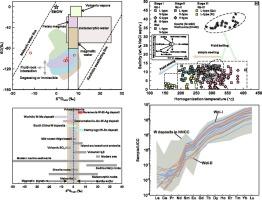中国内蒙古那仁乌拉石英脉型W矿床的起源:寄主花岗岩地球化学、流体包裹体、H-O-S 同位素和黑钨矿痕量元素的启示
IF 2.7
3区 地球科学
Q2 GEOSCIENCES, MULTIDISCIPLINARY
引用次数: 0
摘要
与石英共生的钨矿是钨矿床中常见的热液矿物,其地球化学特征可用于制约钨矿化。在这里,我们发现那仁乌拉矿床是中国东北华北克拉通北缘典型的石英脉型钨矿床,与早白垩世花岗岩在时空上有关联,为解密钨矿化过程提供了契机。所有矿体均由一系列东北走向的黑钨矿-多金属硫化物石英脉组成,伴有强烈蚀变,主要赋存于早白垩世单斜花岗岩和斑状单斜花岗岩中。确定了三个成矿阶段(I) 石英-白钨矿,(II) 石英-白钨矿-硫化物,以及 (III) 石英-萤石-方解石。LA-ICP-MS微量元素分析表明,黑钨矿(I)和(II)具有相似的微量元素、REEN模式和总体一致的Nb/Ta和Y/Ho比率,表明纳伦乌拉矿床的W矿化过程中只有单一的流体来源和演化过程。石英和黑钨矿的流体包裹体微测温以及H-O同位素表明,纳伦乌拉矿床的早期成矿流体主要是岩浆水,温度和盐度相对中高,而晚期成矿流体则与陨石水混合,温度和盐度中低。黄铁矿的δ34S值(4.63-6.65‰,平均值=5.44‰)进一步支持了硫化物的岩浆成因。纳伦乌拉矿床的成矿机制包括流体沸腾和流体-岩石相互作用,这是控制黑钨矿和硫化物沉积的两个主要因素,而简单的冷却和流体混合也可能促进了黑钨矿的沉淀。本文章由计算机程序翻译,如有差异,请以英文原文为准。

Origin of the Narenwula quartz vein-type W deposit, Inner Mongolia, China: Insights from geochemistry of hosting granites, fluid inclusions, H-O-S isotopes, and wolframite trace elements
Wolframite that coexists with quartz is common hydrothermal mineral in tungsten deposits, and its geochemical features can be used to constrain the tungsten mineralization. Here we show that the Narenwula deposit is a typical quartz vein-type W deposit on the northern margin of the North China Craton, Northeast China, and temporally and spatially associated with Early Cretaceous granitoids, provides an opportunity to decipher the W mineralization process. All the orebodies are composed of a series of northeast- trending wolframite-polymetallic sulfides bearing quartz veins accompanied by intense alterations, mainly hosted in the Early Cretaceous monzogranite and porphyraceous monzogranite. Three paragenetic stages were identified: (I) quartz-wolframite, (II) quartz-wolframite-sulfide, and (III) quartz-fluorite-calcite. LA−ICP−MS trace element analyses revealed that both wolframite (I) and (II) have similar trace elements, REEN patterns, and overall consistent Nb/Ta and Y/Ho ratios, indicate a single fluid source and evolution in the W mineralization of the Narenwula deposit. Fluid inclusions microthermometry of quartz and wolframite, coupled with H-O isotopes suggest that the early ore-forming fluids of the Narenwula deposit are mainly magmatic water with relatively moderate-to-high temperature and salinity, while the late ore-forming fluids are mixed with meteoric water, with medium-to low temperature and low salinity. The δ34S values of pyrite (4.63–6.65 ‰, average = 5.44 ‰) further support a magmatic origin for the sulfides. The metallogenic mechanisms at the Narenwula deposit include fluid boiling and fluid-rock interactions were the two major factors controlling the deposition of wolframite and sulfide, while simple cooling and fluid mixing may have also promoted wolframite precipitation.
求助全文
通过发布文献求助,成功后即可免费获取论文全文。
去求助
来源期刊

Journal of Asian Earth Sciences
地学-地球科学综合
CiteScore
5.90
自引率
10.00%
发文量
324
审稿时长
71 days
期刊介绍:
Journal of Asian Earth Sciences has an open access mirror journal Journal of Asian Earth Sciences: X, sharing the same aims and scope, editorial team, submission system and rigorous peer review.
The Journal of Asian Earth Sciences is an international interdisciplinary journal devoted to all aspects of research related to the solid Earth Sciences of Asia. The Journal publishes high quality, peer-reviewed scientific papers on the regional geology, tectonics, geochemistry and geophysics of Asia. It will be devoted primarily to research papers but short communications relating to new developments of broad interest, reviews and book reviews will also be included. Papers must have international appeal and should present work of more than local significance.
The scope includes deep processes of the Asian continent and its adjacent oceans; seismology and earthquakes; orogeny, magmatism, metamorphism and volcanism; growth, deformation and destruction of the Asian crust; crust-mantle interaction; evolution of life (early life, biostratigraphy, biogeography and mass-extinction); fluids, fluxes and reservoirs of mineral and energy resources; surface processes (weathering, erosion, transport and deposition of sediments) and resulting geomorphology; and the response of the Earth to global climate change as viewed within the Asian continent and surrounding oceans.
 求助内容:
求助内容: 应助结果提醒方式:
应助结果提醒方式:


